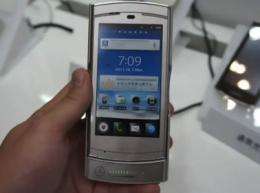October 4, 2011 weblog
Ten-minute charge makes battery spectacle at CEATEC

(PhysOrg.com) -- CEATEC Japan, the Tokyo event focused on new devices in electronics and IT, opens this week with lots of pre-buzz circling around a little gadget that keeps smartphones from dying, courtesy of NTT DoCoMo and NEC. Engadget seeded the interest after visiting NTT DoCoMo’s booth to examine an NTT smartphone battery. The charge takes only ten minutes. The battery lives in an external pack.
NTT DoCoMo and NEC have developed this prototype as an external lithium ion battery sleeve which is placed on a user’s smartphone. "A pair of amp meters compared the power draw of a standard battery with that of the ultra high speed charger, which pulled 0.55 amps and 5.86 amps, respectively -- at least according to the demo equipment on hand at NTT's CEATEC booth," wrote Zach Honig of Engadget. The battery sleeve's AC adapter supports output of up to 6.0 amps, he added. The video report says it should be able to power a phone for at least a few hours.
There is no specific information on a targeted release date or the company’s intentions to have the device work with any other phone than the one it works with now, the NEC Medias Android smartphone, available to the Japanese market. NCC DoCoMo's press release describing its CEATEC showcase only said this: "This special battery jacket for smartphones achieves a full charge in just 10 minutes. A recharging indicator will show how the jacket will charge a smartphone 10~15 times faster than conventional charging devices."
Like other companies at the CEATEC show, NTT DoCoMo is eager to show its innovative edge. The prototype is one of numerous gadgets that the company seeks to publicize here. According to the company release, "Three types of special jackets for smartphones are equipped with sensors that can be customized to measure ultraviolet light and bad breath, gamma radiation and body fat.”
As for the new gadget for high-speed battery charging, technology users need little imagination, only hope, to anticipate battery charger solutions to ease the inconvenience of having to wait around for their smart devices to power up. Waiting around for only ten minutes would be an advantage.
A frequent complaint generally is that smartphones have come a long way yet battery technologies to support them have not kept pace. Earlier this year, Megan Geuss wrote in PC World: "Battery makers are trying to wring the last bits of capacity out of 15-year-old lithium ion technology, while device and app makers seem to be just waking up to the seriousness of the problem."
© 2011 PhysOrg.com




















